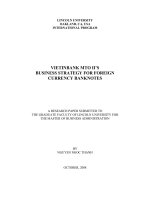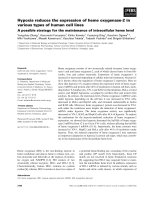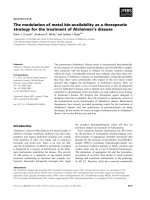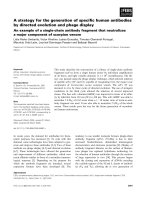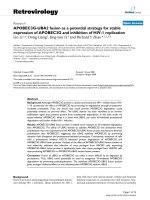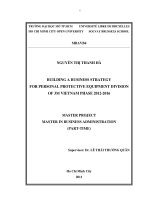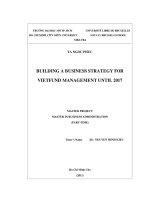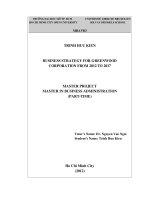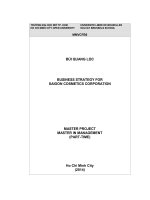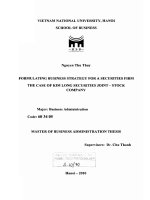Business strategy for consumer lending of HSBC
Bạn đang xem bản rút gọn của tài liệu. Xem và tải ngay bản đầy đủ của tài liệu tại đây (861.9 KB, 88 trang )
vietnam national university, HANOI
school of business
Nguyen Viet Thang
BUSINESS STRATEGY FOR CONSUMER
LENDING OF HSBC
master of business administration thesis
Hanoi - 2007
vietnam national university, HANOI
school of business
Nguyen Viet Thang
BUSINESS STRATEGY FOR CONSUMER
LENDING OF HSBC
Major: Business Administration
Code: 60 34 05
Master of business administration thesis
Supervisors:
1. DR.ChU THANH
2. MRS TRAN PHUONG LAN,MBA
Hanoi – 2007
vi
TABLE OF CONTENTS
ACKNOWLEDGEMENTS i
ABSTRACT ii
TÓM TẮT iii
LIST OF ABBREVIATIONS v
LIST OF TABLES v
LIST OF FIGURES v
INTRODUCTION 1
1. Aim and objective 2
2. Company profiles 3
3. Problem Area 4
CHAPTER 1: LITERRATURE REIVEW 6
1.1. Definition 6
1.2 Strategic management process 11
1.3. Strategic management model 14
1.4. Evaluating and choosing a value added strategy 30
1.4.1 Evaluation Principles 30
1.4.2 Requirement 30
1.4.3 The main factor for choosing business plan 31
1.4.4 Choosing Process 31
1.5 The Strategy Hierachy 32
vii
1.6 Type of Corporate Business Strategy 33
CHAPTER 2: HSBC AND CAR LOAN PRODUCT 36
2.1. Introduction of HSBC 36
2.1.1 HSBC Global 36
2.1. Introduction of HSBC 36
2.1.2 The HongKong and Shang Hai Banking Corporation Limited 37
2.2. HSBC in Viet Nam 41
2.3. Business Environment Analysis 44
2.3.1. External Analysis 44
2.3.2. Internal Analysis (Industry Environment) 49
2.3.3. Internal Analysis (The company) 69
2.3.4. Choosing the right strategy 71
CHAPTER 3: CONCLUSION AND RECOMMENDATION 72
3.1. Choosing the right strategy 72
3.2. Detailed Functional strategy 77
3.2.1. Business Development Strategies 77
3.2.1. Product Strategies 77
3.2.2. Product Strategies 79
3.2.3. Marketing Strategies 81
CONCLUSION 85
REFERENES 86
APPENDIX 87
v
List of abbreviations
HSBC
The Hong Kong and ShangHai Banking Corporation
HSBC Viet Nam
The Hong Kong and Shang Hai Banking Corporation
Limited in Viet Nam
PFS
Personal Financial Services
List of tables
Page
Table: 1.1 Three stages of strategic process
14
Table 2.3.1 Toyota Car Loan payment method
52
Table 2.3.2 Competitor analysis matrix
54
Table 2.3.3 Brief about HSBC Car loan
59
Table 2.3.4 Approval/ Underwriting Criteria
64
Table 2.3.5 Number of Car sales 2006 -2007
69
Figure 3.2.1: Ha Noi – Toyota Car Loan market share
82
List of figures
Page
Figure 2.1.2 Profit before tax
38
Figure 2.1.2 Total assets
38
Figure 2.3.1 Viet Nam Economical Indicator over times
47
Figure 2.3.2: Side of the market
49
Figure 2.3.3 Car sale number of all major brands
50
Figure 2.3.4 Staff of PFS
70
1
INTRODUCTION
To get an introductory illustration of the studied subject, in this chapter, the
author is going to describe a basic background of the theme, determine the
problem area and identify the purpose of the research, followed by an
illustration of its aims and objectives.
Economic globalization is a natural development trend of the labor division
and cooperation around the world, with the support of modern science and
technology. This trend is irreversible and it involves any nation, covers most
the facets of the socio-economic life, promote competition, strengthen
cooperation while increasing the interdependence between economies. This
double-side nature of international economic integration depends on the
condition and level of economic development in each nation.
In banking and finance system, international integration opens an opportunity
to international cooperation in expand their business to other countries which
was very sensitive and hard to enter. When coming to a developing country
like Viet Nam, foreign banks can take advantage of capital, modern
technology, management experience, and etc to develop the comparative
advantage to catch up with the local competition that establish a large
distribution channel and have depth knowledge about the local business
environment. However, international integration in banking is also associated
with the rising risk and sensitivity of the domestic financial market in front of
the volatile world market. The opening up of the new financial market will
pave the way for foreign banks to penetrate the domestic financial market,
with the number of strong competitors in the local market.
2
Becoming an official member of WTO (by end of 2006). Viet Nam target is
to fully integrate to the global economic and financial system. In the new
situation, there is a great opportunity for foreign bank especially retail bank
like HSBC to enter the new and emerging market of Viet Nam.
From the above discussion, it can be seen that with the opportunity to enter
the new market. HSBC now experiencing a game with some tough
competition in the race of obtain new customer, win their loyalty and remain
the business with them. The most pressing point is that Vietnamese banks in
particular and financial institutions are important corporation that work in
sensitive situation therefore they have a strong back up from local
government. In addition, they have an reckonable distribution channel with a
good customer base. Hence, to setup distribution channel and build up
database is some of core targets for foreign bank to achieve in the new
situation.
1. Aim and objective
This thesis‘s aim is to answer the question what the Bank should do in the
new context of accessing WTO to effectively setup the new business Strategy
and build up the customer database in order to enter a very promising market
like Viet Nam and equal compete with other local and foreign banks.
The objectives of the research, therefore, will be as follow:
1) Literature review of Strategy and strategic management.
2) An evaluation of the Bank‘s current position of car loan product and
assess the bank‘s current strategy on kept going to be the best retail
bank and build up the bank customer database.
3
3) Highlight areas for improvement for HSBC.
2. Company profiles
Company profile
The Hong Kong & Shanghai Banking Corporation have been operation in
Vietnam since 1880 with quite long history. However, after the Civil war,
they have just come back to Vietnam in 1995 in HCM City and 2005 in Ha
Noi. With long experience in banking services and a contingent of well-
trained, dynamic and enthusiastic staff, the Bank continues to play a crucial
role in Vietnam's banking sector. For the recent year, the bank have awarded
many important prize such as: ―best foreign bank in Vietnam‖ in and ―bst
bank in Vietnam‖ in by The Banker. In parallel with its development of
banking products and services, the Bank has continued to expand its network
in order to better serve its customers' demand. At the moment, the Bank was
recognized for its well-established group consisting of 02 major branches at
two important city of Vietnam as Ha Noi and Ho Chi Minh City, one
representative offices in Can Tho. In the future, when new law of banking
system come to effect and HSBC will be treated as local bank, they will have
more and more branches in all over the countries
Currently, the Bank have operate many activities in Vietnam such as:
Deposit: Current account, saving account (both VND and USD),
mutual fund …
Loan: include consumer credit, overdraft, trade finance, project
finance …
4
Money transaction include account transaction, ATM, Credit card
…
Securities services …
…
a. Problem Area
- new to the market
- do not know the market well as the local ones
- high in capital, technologies, experienced …
Becoming an official member of WTO therefore the target for Vietnam is to
fully integrate to the global economic and financial system. International
integration will generate more opportunities and more challenges. ‗After
joining the WTO, we have to accept a wider opening of banking services.
Foreign banks and credit organizations will have more opportunities to
penetrate the Vietnamese market. And thus, the competition pressure against
domestic banks is also higher‘ (Governor Le Duc Thuy, 2006)
Therefore, with this trend of development, we can see lots of foreign bank
that coming or expanding their business into Vietnam such as ANZ, Citi
Bank, GE capital, UOB Bank … and HSBC is not exceptional. And the
problem of HSBC Vietnam in particular and other bank in general is how to
expand their business and win the sweet cake of this new and emerging
market as much as possible because at this moment, local bank still have
powerful backup from Vietnam governor.
Within the scope of this paper, I would like to emphasize a number of
activities in the banking sector of foreign bank in Vietnam in general and
5
HSBC Vietnam in particular for the car loan market that would partly show
the readiness for international integration and accession of Vietnam's banking
system in order to rise the challenges of an exiting system of local bank.
Purpose
The purpose of this thesis is to conduct a theoretical and empirical study to
analyze and find out the strategy for Car loan product of HSBC, one of the
world largest retail bank after Vietnam with the WTO accession.
6
CHAPTER 1: LITERRATURE REVIEW
1.1. Definition
The concept of strategy has been borrowed from the military and adapted for
use in business. A review of what noted writers about business strategy have
to say suggests that adopting the concept was easy because the adaptation
required has been modest. In business, as in the military, strategy bridges the
gap between policy and tactics. Together, strategy and tactics bridge the gap
between ends and means. This paper reviews various definitions of strategy
for the purpose of clarifying the concept and placing it in context. The
author's aim is to make the concepts of policy, strategy, tactics, ends, and
means more useful to those who concern themselves with these matters
Some Language Basics
Strategy is a term that comes from the Greek strategia, meaning
"generalship." In the military, strategy often refers to maneuvering troops into
position before the enemy is actually engaged. In this sense, strategy refers to
the deployment of troops. Once the enemy has been engaged, attention shifts
to tactics. Here, the employment of troops is central. Substitute "resources"
for troops and the transfer of the concept to the business world begins to take
form.
Strategy also refers to the means by which policy is affected, accounting for
Clauswitz‘ famous statement that war is the continuation of political relations
via other means. Given the centuries-old military origins of strategy, it seems
sensible to begin our examination of strategy with the military view. For that,
there is no better source than B. H. Liddell Hart.
7
Strategy According to B. H. Liddell Hart
In his book, Strategy, Liddell Hart examines wars and battles from the time of
the ancient Greeks through World War II. He concludes that Clausewitz‘
definition of strategy as "the art of the employment of battles as a means to
gain the object of war" is seriously flawed in that this view of strategy
intrudes upon policy and makes battle the only means of achieving strategic
ends. Liddell Hart observes that Clausewitz later acknowledged these flaws
and then points to what he views as a wiser definition of strategy set forth by
Moltke: "the practical adaptation of the means placed at a general‘s disposal
to the attainment of the object in view." In Moltke's formulation, military
strategy is clearly a means to political ends.
Concluding his review of wars, policy, strategy and tactics, Liddell Hart
arrives at this short definition of strategy: "the art of distributing and applying
military means to fulfill the ends of policy." Deleting the word "military"
from Liddell Hart‘s definition makes it easy to export the concept of strategy
to the business world. That brings us to one of the people considered by many
to be the father of strategic planning in the business world: George Steiner.
Strategy According to George Steiner
George Steiner, a professor of management and one of the founders of The
California Management Review, is generally considered a key figure in the
origins and development of strategic planning. His book, Strategic Planning
[2], is close to being a bible on the subject. Yet, Steiner does not bother to
define strategy except in the notes at the end of his book. There, he notes that
strategy entered the management literature as a way of referring to what one
did to counter a competitor‘s actual or predicted moves. Steiner also points
out in his notes that there is very little agreement as to the meaning of strategy
8
in the business world. Some of the definitions in use to which Steiner pointed
include the following:
2. Strategy is that which top management does that is of great importance to
the organization.
3. Strategy refers to basic directional decisions, that is, to purposes and
missions.
4. Strategy consists of the important actions necessary to realize these
directions.
5. Strategy answers the question: What should the organization be doing?
6. Strategy answers the question: What are the ends we seek and how should
we achieve them?
Steiner was writing in 1979, at roughly the mid-point of the rise of strategic
planning. Perhaps the confusion surrounding strategy contributed to the
demise of strategic planning in the late 1980s. The rise and subsequent fall of
strategic planning brings us to Henry Mintzberg.
Strategy According to Henry Mintzberg
Henry Mintzberg, in his 1994 book, The Rise and Fall of Strategic Planning
[3], points out that people use "strategy" in several different ways, the most
common being these five:
- Strategy is a plan, a "how," a means of getting from here to there.
- Strategy is a ploy, really just a specific manoeuvre intended to outwit
an opponent or competitor.
- Strategy is a pattern in actions over time; for example, a company that
regularly markets very expensive products is using a "high end"
strategy.
9
- Strategy is position; that is, it reflects decisions to offer particular
products or services in particular markets.
- Strategy is perspective, that is, vision and direction.
Mintzberg argues that strategy emerges over time as intentions collide with
and accommodate a changing reality. Thus, one might start with a perspective
and conclude that it calls for a certain position, which is to be achieved by
way of a carefully crafted plan, with the eventual outcome and strategy
reflected in a pattern evident in decisions and actions over time. This pattern
in decisions and actions defines what Mintzberg called "realized" or emergent
strategy.
Mintzberg‘s typology has support in the earlier writings of others concerned
with strategy in the business world, most notably, Kenneth Andrews, a
Harvard Business School professor and for many years editor of the Harvard
Business Review.
Strategy According to Michael Porter
In a 1996 Harvard Business Review article [5] and in an earlier book [6],
Porter argues that competitive strategy is "about being different." He adds, "It
means deliberately choosing a different set of activities to deliver a unique
mix of value." In short, Porter argues that strategy is about competitive
position, about differentiating yourself in the eyes of the customer, about
adding value through a mix of activities different from those used by
competitors. In his earlier book, Porter defines competitive strategy as "a
combination of the ends (goals) for which the firm is striving and the means
(policies) by which it is seeking to get there." Thus, Porter seems to embrace
strategy as both plan and position. (It should be noted that Porter writes about
competitive strategy, not about strategy in general.)
10
What Is Strategy?
Then what is strategy? The answer is:
Strategy is all these—it is perspective, position, plan, and pattern. Strategy is
the bridge between policy or high-order goals on the one hand and tactics or
concrete actions on the other. Strategy and tactics together straddle the gap
between ends and means. In short, strategy is a term that refers to a complex
web of thoughts, ideas, insights, experiences, goals, expertise, memories,
perceptions, and expectations that provides general guidance for specific
actions in pursuit of particular ends. Strategy is at once the course we chart,
the journey we imagine and, at the same time, it is the course we steer, the trip
we actually make. Even when we are embarking on a voyage of discovery,
with no particular destination in mind, the voyage has a purpose, an outcome,
an end to be kept in view.
Strategy, then, has no existence apart from the ends sought. It is a general
framework that provides guidance for actions to be taken and, at the same
time, is shaped by the actions taken. This means that the necessary
precondition for formulating strategy is a clear and widespread understanding
of the ends to be obtained. Without these ends in view, action is purely
tactical and can quickly degenerate into nothing more than a flailing about.
When there are no "ends in view" for the organization writ large, strategies
still exist and they are still operational, even highly effective, but for an
individual or unit, not for the organization as a whole. The risks of not having
a set of company-wide ends clearly in view include missed opportunities,
fragmented and wasted effort, working at cross purposes, and internecine
warfare. A comment from Lionel Urwick's classic Harvard Business Review
article regarding the span of control is applicable here [11]:
11
"There is nothing which rots morale more quickly and more completely
than . . . the feeling that those in authority do not know their own
minds."
For the leadership of an organization to remain unclear or to vacillate
regarding ends, strategy, tactics and means is to not know their own minds.
The accompanying loss of morale is enormous.
One possible outcome of such a state of affairs is the emergence of a new
dominant coalition within the existing authority structure of the enterprise,
one that will augment established authority in articulating the ends toward
which the company will strive. Also possible is the weakening of authority
and the eventual collapse of the formal organization. No amount of
strategizing or strategic planning will compensate for the absence of a clear
and widespread understanding of the ends sought.
1.2. Strategic management process
Strategic management is the art and science of formulating, implementing
and evaluating cross-functional decisions that will enable an organization to
achieve its objectives. It is the process of specifying the organization's
objectives, developing policies and plans to achieve these objectives, and
allocating resources to implement the policies and plans to achieve the
organization's objectives. Strategic management, therefore, combines the
activities of the various functional areas of a business to achieve
organizational objectives. It is the highest level of managerial activity, usually
formulated by the Board of directors and performed by the organization's
Chief Executive Officer (CEO) and executive team. Strategic management
provides overall direction to the enterprise and is closely related to the field of
Organization Studies.
12
Strategic process
Strategic management is a combination of three main processes which are as
following:
o Strategy formulation
- Performing a situation analysis, self-evaluation and competitor analysis:
both internal and external; both micro-environmental and macro-
environmental.
- Concurrent with this assessment, objectives are set. This involves crafting
vision statements (long term view of a possible future), mission statements
(the role that the organization gives itself in society), overall corporate
objectives (both financial and strategic), strategic business unit objectives
(both financial and strategic), and tactical objectives.
- These objectives should, in the light of the situation analysis, suggest a
strategic plan. The plan provides the details of how to achieve these
objectives.
This three-step strategy formulation process is sometimes referred to as
determining where you are now, determining where you want to go, and then
determining how to get there. These three questions are the essence of
strategic planning. SWOT Analysis: I/O Economics for the external factors
and RBV for the internal factors.
o Strategy implementation
o Allocation of sufficient resources (financial, personnel, time,
technology support)
o Establishing a chain of command or some alternative structure (such as
cross functional teams)
13
o Assigning responsibility of specific tasks or processes to specific
individuals or groups
o It also involves managing the process. This includes monitoring results,
comparing to benchmarks and best practices, evaluating the efficacy
and efficiency of the process, controlling for variances, and making
adjustments to the process as necessary.
o When implementing specific programs, this involves acquiring the
requisite resources, developing the process, training, process testing,
documentation, and integration with (and/or conversion from) legacy
processes.
Strategy evaluation: Measuring the effectiveness of the organizational
strategy.
Table 1.1 Three stages of strategic process
Strategy
formulation
Performing a
situation analysis,
self-evaluation
and competitor
analysis: both
internal and
external; both
Summarize,
analyze
Chose
objectives,
selecting and
determining
the strategy
14
micro-
environmental and
macro-
environmental.
Strategy
Implementation
Re evaluate,
Propose new
policy for strategy
implementation
Establish goal and
solution for long
term and each year
Resources
allocation
according to
specific
strategy
Strategy
Evaluation
Recheck internal,
external elements
Making
comparison
Adjust goal,
policy, solution
1.3. Strategic management model
Strategic management is about collecting all business activities, then
assessing, examining and adjusting value-added strategy in order to ensure
that organization makes use of all its opportunities as well as limiting or
deleting all threats of its objective achievement.
External Analysis (PEST, Five Force Model …)
PEST Model
The acronym PEST (abbreviation of Political – Economic – Social –
Technological) is a framework for the analysis of 4 macro-environment
factors. PEST model is usually used to evaluate the effect of external
environment on all companies so that a feasible strategy could be determined.
15
In PEST model, macro environment factors are represented as every thing that
cover and regulate your business as followed:
[source:www.provenmodels.com]
PEST analysis is conducted as followed:
- Collect all current information and forecast which factors will affect the
firm‘s business. - Arrange those factors in order of the influence of those
factors
- Evaluate the effect of each factor then determining any opportunities and
challenges affected by the macro-environment.
Five Forces
Porter's 5 forces analysis is a framework for an industry analysis and business
strategy development developed by Michael E. Porter in 1979. It uses
16
concepts developed in Industrial Organization economics to derive 5 forces
that determine the competitive intensity and therefore attractiveness of a
market. Porter referred to these forces as the microenvironment, to contrast it
with the more general term macro environment. They consist of those forces
close to a company that affect its ability to serve its customers and make a
profit. A change in any of the forces normally requires a company to re-assess
the marketplace.
[Source: Competitive Advantage, Michael Porter, 1985]
Porter's Five Forces include three forces from 'horizontal' competition: threat
of substitute products, the threat of established rivals, and the threat of new
entrants; and two forces from 'vertical' competition: the bargaining power of
suppliers, bargaining power of customers.
Degree of rivalry
17
For most industries, this is the major determinant of the competitiveness of
the industry. Sometimes rivals compete aggressively and sometimes rivals
compete in non-price dimensions such as innovation, marketing, etc.
Number of main competitors increases rivalry because more firms must
compete for the same customers and resources.
Slow of industry growth: causes firms to fight for market share.
High fixed costs result in economy of scale effect that increases rivalry.
When total costs are mainly fixed costs, the firm must produce near capacity
to attain the lowest unit costs. Since the firm must sell this large quantity of
product, high level of production lead to a fight for market share and results in
increased rivalry.
Exit barriers place a high cost on abandoning the product. It makes firms
must remain in an industry even if the venture is not profitable.
Diversity of competitors with different cultures, histories, and philosophies
make an industry unstable. There is greater possibility for mavericks and for
misjudging rival‘s moves.
Informational complexity and asymmetry
Level of advertising expense
The threat of the entry of new competitors
It is not only incumbent rivals that pose a threat to firms in an industry; the
possibility that new firms may enter the industry also affects competition. In
theory, any firm should be able to enter and exit a market and if free entry and
exit exists, then profits always should be nominal. In reality, however,
industries possess characteristics that protect the high profit levels of firms in
the market and inhibit additional rivals from entering the market. These are
18
barriers to entry. Barriers to entry are unique industry characteristics that
define the industry. Barriers reduce the rate of entry of new firms, thus
maintaining a level of profits for those already in the industry. From a
strategic perspective, barriers can be created or exploited to enhance a firm‘s
competitive
Profitable markets that yield high returns will draw firms. The result is many
new entrants, which will effectively decrease profitability. Unless the entry of
new firms can be blocked by incumbents, the profit rate will fall towards a
competitive level (perfect competition).
Barrier to entry comes from several sources:
The existence of barriers to entry (patents, rights, etc.)
economies of product differences
brand equity
switching costs or sunk costs
capital requirements
access to distribution
absolute cost advantages
learning curve advantages
expected retaliation by incumbents
government policies
The threat of substitute products
Substitute products refer to products in other industries. To the economist, a
threat of substitutes exists when a product‘s demand is affected by the price
change of a substitute product.
19
A product‘s price elasticity is affected by substitute products – as more
substitutes become available, the demand becomes more elastic since
customers have more alternatives. A close substitute product constrains the
ability of firms in an industry to raise prices.
The existence of close substitute products increases the propensity of
customers to switch to alternatives in response to price increases (high
elasticity of demand).
buyer propensity to substitute
relative price performance of substitutes
buyer switching costs
perceived level of product differentiation
The bargaining power of suppliers
Also described as market of inputs, suppliers of raw materials, components,
and services (such as expertise) to the firm can be a source of power over the
firm. Suppliers may refuse to work with the firm, or e.g. charge excessively
high prices for unique resources.
supplier switching costs relative to firm switching costs
degree of differentiation of inputs
presence of substitute inputs
supplier concentration to firm concentration ratio
threat of forward integration by suppliers relative to the threat of backward
integration by firms
cost of inputs relative to selling price of the product
The bargaining power of customers
20
The power of buyers is the impact that customers have on a producing
industry. In general, when buyer power is strong, the relationship to the
producing industry is near to what an economist terms a monopsony – a
market in which there are many suppliers and one buyer. Under such market
conditions, the buyer sets the price. In reality few pure monopsonies exist, but
frequently there is some asymmetry between a producing industry and buyers.
For example, buyers are powerful if
+ Buyers are concentrated - there are a few buyers with significant market
share
+ Buyers purchase a significant proportion of output – distribution of
purchases or if the product is standardized.
Internal Analysis
In his 1985 book Competitive Advantage, Michael Porter introduced a
generic value chain model that comprises a sequence of activities found to be
common to a wide range of firms. Porter identified primary and support
activities as followed:
Primary activities include: Inbound logistics – Operations – Outbound
Logistics – Marketing & Sales – Service
Support Activities: Firm Infrastructure – HR Management – Technology
Development – Procurement
Value chain mode
